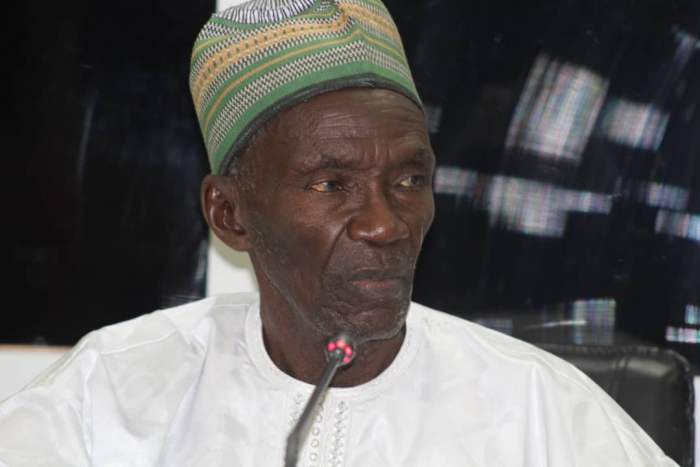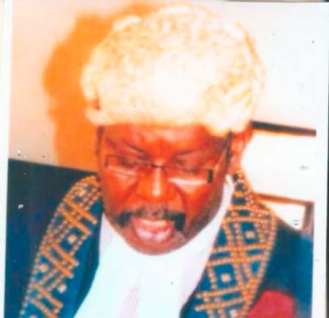
A Senegambian Insight by Fafa Edrissa MBai
Fafa Edrissa Mbai studied Law and Political Economy in the UK from 1970 to 1975 and it was during this period that he became a lawyer. On his return to The Gambia, he held senior positions in the judiciary, including Minister of Justice from 1982 to 1984. He has written numerous articles and several books. He published, among others, in 1992 in England a book entitled A Senegambian Insight (224 pages), which is an adaptation of his thesis "Problems of Integration in Senegambia: A Case-Study of Inter-State Relations in Contemporary Africa", defended in 1975 for the Master's degree at Keele University. The date of 1975 is remarkable since the essence of this reflection was produced several years ago; and if it is three years after the failure of the Senegambian Confederation (1981-1989) that the author published his work, it is because the basic problems remain and deserve to be seriously analysed.
The book has ten chapters (p 1 to 116), and the author has attached 31 documents (p 117 to 224) which give the reader access to various official texts from 1875 to 1970 between France and Great Britain, then between Gambia, Senegal and neighbouring states.
The first two chapters (Senegambia as a Geo-Historical Region and Senegambia: Peoples and Traditional Socio-Political Structures) attempt to give the idea of 'Senegambia' as a foundation that does not cover the present-day spaces of the states of The Gambia and Senegal. It rather refers to a wider geographical, historical and social reality that stretches from the Futa Toro (at the Senegal-Mauritania border) to the Futa Jalon (in Guinea). If Senegambia had a meaning, it could not have been given by arbitrary and artificial external factors linked to antagonisms between rival colonial powers. Therefore, these two chapters seek to manifest an initial unity that alone can give meaning to the contemporary search for reunification.
The third chapter (The Colonial Partition) recounts the various Franco-British events that led to the division into two territories in the 18th century, reconfirmed by a treaty in April 1889, which the author describes as "the most irrational frontier ever created was signed". The next two chapters (Senegambia Under Colonial Rule and The Differential Impact of Colonial Rule) compare the two modes of colonial administration and their various effects, particularly on the respective local elites and the economic and financial life of the populations.
The irrationality of this partition into two states necessarily leads, if not to the idea of political unity, at least to what the author calls in Chapter 6, The Need of Integration. He then shows the first attempts made (Chapter 7 Attempts at Integration) but also the limits (Chapter 8 The Limitations of Integration). To prove that the beginnings and limitations of certain undertakings cannot lead to the abandonment of at least socio-economic integration, the author then takes the example of Cameroon (Chapter 9 The Reunification of Cameroon) and other countries in the world (Chapter 10 Relevant Precedents of Integration Schemes) ranging from the European Community, the Central American Common Market, ECOWAS and the Mano River Union.
At the end of his work, Fafa Ebrima M'Bai announces the subsequent publication of two other books, Senegambia, a Geo-Historical Socio-Economic and Political Study and Senegambia: The Confederation that Never Was. It is clear that these books, when published, will provide the necessary complement to this first book, especially after an analysis of the failure of the Senegambian Confederation, which is not included in this book.
In the Service of My Beliefs by Fafa Edrissa MBai
Fafa Edrissa MBai, born in 1947, studied Law and Political Economy in Great Britain after serving in the administration, then returned to the country to work as a lawyer and magistrate before reaching the highest position as Minister of Justice (1982-1984).
In 1992, during the first republic, he had a 200-page book printed in Britain entitled In the Services of My Beliefs. This book is not an autobiography but a collection of 43 articles and speeches written or delivered between 1974 and 1992. To know someone, and even more so a public person, writings and speeches are not enough, as one must also judge and appreciate actions, but this kind of document is no less important as it gives an idea of the opinions and the art of convincing of the author. It is good to know the intentions and motivations of the men who have animated and led the country's political life, even for a relatively short period.
The documents are classified in chronological order: 5 between 1974 and 1980; 10 for 1982; 17 for 1983; 6 for 1984; the last 5 between 1985 and 1992. It can therefore be seen that the majority of the texts (36 out of 43) correspond to the period of full ministerial activity of Fafa Edrissa M'bai.
While most of the texts were produced in The Gambia and for Gambians, a few were produced abroad for other audiences: in Windsor (Great Britain), in Montego Bay (Jamaica), 2 in Colombo (Sri Lanka), 2 in Addis Ababa (Ethiopia), in Dakar (Senegal), in Budapest (Hungary), in Wellington (New Zealand). In the case of Gambia, several speeches were made in the National Assembly during legislative debates (12) or for ministerial activities, in particular at the Supreme Court (4); but the other speeches were made in schools (Gambia High School, Armitage, Gambia College, GTTI) and at various ceremonies.
The book contains only three newspaper articles: two were published in 1976 in The Gambia News Bulletin and deal with legal issues. One deals with the operation of African legal systems, and the other with the relationship between British Law and Islamic practice on inheritance and wills. The third article, dated from 1984 and published in The Gambia Times, deals with the relationship between the Press and politicians.
When history is too recent, it isn't easy to judge the actors and their actions in all serenity and objectivity. Time must be allowed to do its work to give historians the necessary distance. On the other hand, the compilation of documents is indispensable, as texts are often lost or difficult to find and collect, and it is partly thanks to them that we will be able to make a judgement later on. In this sense, the contribution of Fafa Edrissa M'Bai is very useful.
Law, Justice and Governance by Hassan B. Jallow
 Hassan B. Jallow's career is linked to the judiciary and Law. He was Minister of Justice for ten years, from 1984 to 1994. Even before taking up this post, he was heavily involved in promoting human rights at the Commonwealth, the OAU and The Gambia level. He was a member of the experts meeting in Dakar in 1979 that prepared the African Charter on Human and Peoples' Rights (adopted in 1981 in Nairobi). He was also directly involved in establishing and operating the African Centre for Democracy and Human Rights Studies in Banjul. He now serves as the Chief Justice of the Gambia.
Hassan B. Jallow's career is linked to the judiciary and Law. He was Minister of Justice for ten years, from 1984 to 1994. Even before taking up this post, he was heavily involved in promoting human rights at the Commonwealth, the OAU and The Gambia level. He was a member of the experts meeting in Dakar in 1979 that prepared the African Charter on Human and Peoples' Rights (adopted in 1981 in Nairobi). He was also directly involved in establishing and operating the African Centre for Democracy and Human Rights Studies in Banjul. He now serves as the Chief Justice of the Gambia.
In 1998, within the framework of this centre, he published a 165-page document entitled Law, Justice and Governance (printed in Dakar) with a preface by Zoé M. Tembo. This book is a selection of 22 texts from the many speeches, articles and interventions that Hassan B. Jallow produced between 1984 and 1998. The aim is to show the main themes and guiding principles of his thinking and action over those two decades. He dedicates these documents to the Gambians because he does not want them to remain a form of literature but to highlight his respect for justice and human rights in collective practice through them.
Hassan B. Jallow's concern is providing democracy with the institutional and legal frameworks indispensable for its functioning. What is the situation of the judiciary itself concerning the political authorities? Does it or does it not have true independence that allows it to be effective? What are the rights of citizens, whether they are prisoners, young people, women or children? For, if there is to be good governance, the Law must legislate in all areas that show each person his or her space for freedom and responsibility and also draw the limits of his or her action. Indeed, those who guarantee the exercise of the Law (magistrates, law enforcement agencies) and citizens must submit to common rules that respect their status as human beings. It is not social position, wealth or poverty that defines the rights of each person. Even a guilty person in prison has imprescriptible rights.
The author's reflection extends to international relations: what is the situation of small states (such as the Gambia) in relation to demographically and economically dominant states? What mutual legal assistance should states give each other? What is the relationship between British Law and the Law of the Commonwealth countries, including the Gambia? For there is an obvious analogy between the relations of individuals (with different statuses of power and wealth) within a community and the relations between states: it is appropriate that the Law assigns to each one the limits of its action so that Force does not prevail over Justice.
Furthermore, the requirement of Justice shows that the Law is evolving and that it must adapt to modern situations while remaining faithful to the aspirations and cultures of citizens.
The Law and Media in The Gambia – by Amie Bensouda
 Ms Amie Bensouda is a lawyer by training. She obtained law degrees in Nigeria, Kenya, Great Britain, Italy and the USA. On her return to The Gambia, this enabled her to occupy high positions of responsibility in the judiciary, and she has worked at the Supreme Court since 1995 (with a similar position in Nigeria).
Ms Amie Bensouda is a lawyer by training. She obtained law degrees in Nigeria, Kenya, Great Britain, Italy and the USA. On her return to The Gambia, this enabled her to occupy high positions of responsibility in the judiciary, and she has worked at the Supreme Court since 1995 (with a similar position in Nigeria).
In 1998, as part of her NGO activities, she published The Law and Media in The Gambia, a small 24-page booklet in Ghana (published by the Media Foundation for West Africa). This NGO, founded in 1997, aims to defend and promote the rights and freedoms of the media, in all its forms, in the sub-region. As a lawyer, Ms Amie Bensouda wanted to take stock of the legislation on the media situation in The Gambia.
From the outset, the age of the laws governing most of the media is apparent, and their deficiency in certain areas. During the colonial period, the media were little developed or non-existent (no private radio or television), and the concern of the coloniser was to protect himself against possible excesses by nationals. However, the Publication Act of 1888, the Telegraph Station Act of 1913, the Newspapers Act of 1940 and the Law of England Application Act are still in force and may be used. Admittedly, more recent texts, in the form of additions and articles of the 1997 Constitution, have provided supplements, but there are still legal gaps. For example, it is surprising that the state radio and television entrusted to Gamtel do not have a precise legal status, etc. On the other hand, however inadequate some of the regulations may be, those that do exist must be enforced.
Ms Bensouda then analyses successively the laws concerning the Press, radio, media protection, public order offences, censorship and access of parties to the media during elections. She bases her remarks on several specific cases (the impeachment of the director of The Touch in 1988, the eviction of Citizen FM, the expulsion of the first editor of the Daily Obsever, etc.), which give her presentation a concrete and useful character.
This study of the relationship between the workings of the State (laws, a system of coercion, etc.) and the means of expressing the diversity of citizens' opinions highlights the real functioning of democracy. It is necessary to seek and find the best possible balance between the institutions that govern a people and the freedom of individuals to publicly express their views on the mechanisms of the state and society. In no country in the world has this balance been found at once, and it is never definitive since the evolution of the media (for example, the Internet today) renews the situations and the obligation to regulate the new information mechanisms. Ms Amie Bensouda's work draws attention to this major problem of democracy and encourages us to work for the freedom of the media within an updated legal framework that guarantees the rules of good functioning for all.
The legal Rights, Duties and Obligations, of The Riparian State of The Gambia, under Bilateral, regional and International Environmental Treaties/Laws and Policies by Dr Henry D.R. Carrol
 Dr Henry D.R. Carrol, born in 1960, returned to The Gambia after completing a degree in Law at the University of London and then the Barrister's Diploma, where he practised first as a barrister and then as a prosecutor in the Supreme Court. In 2000, he submitted a dissertation to the University of Aberystwyth, Wales, for a Master's degree in Environmental Law, focusing on the issue of water law.
Dr Henry D.R. Carrol, born in 1960, returned to The Gambia after completing a degree in Law at the University of London and then the Barrister's Diploma, where he practised first as a barrister and then as a prosecutor in the Supreme Court. In 2000, he submitted a dissertation to the University of Aberystwyth, Wales, for a Master's degree in Environmental Law, focusing on the issue of water law.
This 54-page work, entitled The legal Rights, Duties and Obligations, of The Riparian State of The Gambia, under Bilateral, regional and International Environmental Treaties/Laws and Policies, is particularly interesting in the current global context where the issue of water is becoming a major issue because the world's population is constantly increasing and States are making often abusive uses of watercourses. Given its growing scarcity, water is becoming an increasingly coveted resource, and, on the other hand, the conditions of increasing industrialisation are making the risks of pollution more and more numerous. Lawyers, therefore, have an obligation to clarify the problems involved.
States that share one or more watercourses have been trying for a long time to develop rules for the management and protection of this life-sustaining resource. The Gambia has its source in Guinea Conakry and occupies or crosses the territories of Guinea Bissau and Senegal - Mauritania is also linked to the issue of the Senegal and Gambia basins. In this situation of a shared river basin, two eventualities raise specific legal problems to which Dr H. Carrol tries to provide clarifications and answers: the case of water pollution and the exploitation of the river. To do this, it is important to analyse the bilateral and sub-regional texts (1968, 1978) concerning the Gambia, as well as the international treaties (Helsinki, 1966) and the solution of numerous concrete cases in Europe, in order to be able to provide a legal framework for the solution of possible problems. In order to carry out his analysis, Dr H. Carrol, in chapter 2, defines the concept of a riparian state, and in chapters 3 and 4, examines the rights, duties and obligations that concern the riparian countries of the River Gambia in the light of the various bilateral, regional and international treaties. Chapter 5 shows the impact and application of the Helsinki Treaty Laws; Chapter 6 deals with the application of the 1997 international treaty on non-navigable parts of rivers. Chapter 7 identifies nine general principles of international environmental Law. Chapter 8 examines a case that may one day be of use to The Gambia: that of the construction of a dam on the Danube and the diversion of the river's course, involving Hungary and Czechoslovakia (since split into the Czech Republic and Slovakia) - a project in which both parties were at fault with each other. After the conclusion, three appendices and bibliography, Dr H. Carrol's memoir contributes to understanding legal issues relating to water - in this case, the River Gambia.




